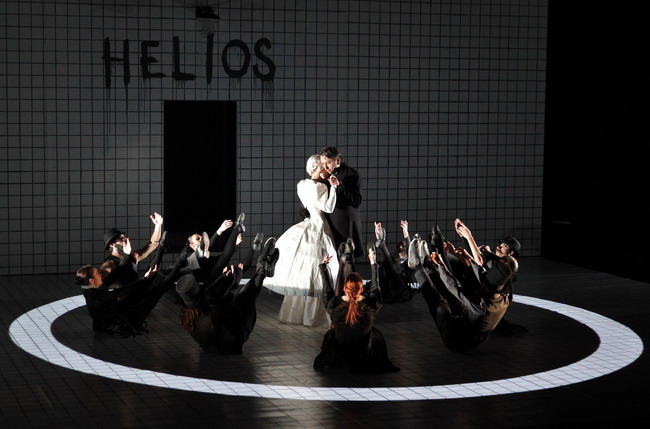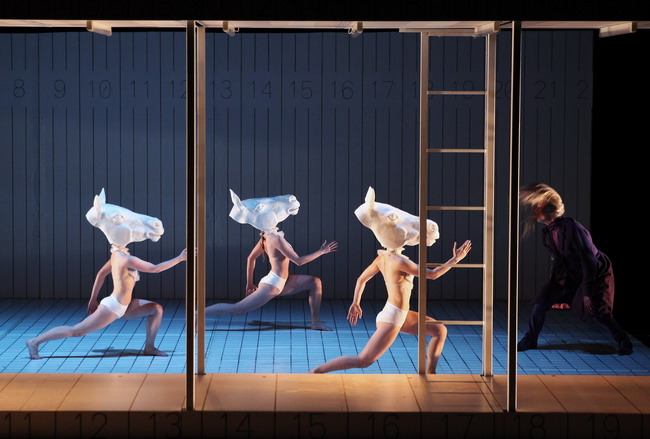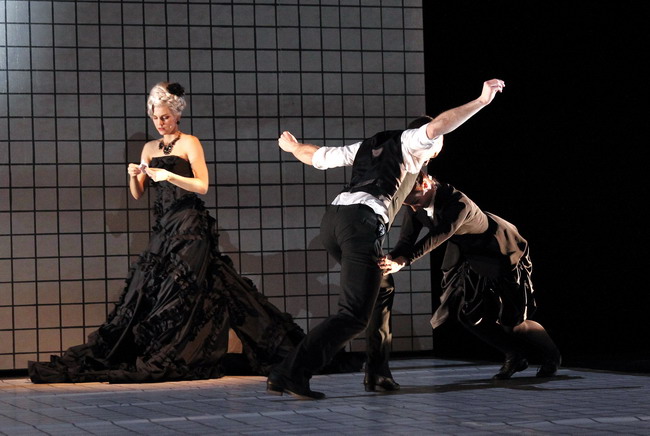Human Locomotion, Stunning Show of Space and Motion
 What happens when you let a set designer and a choreographer create freely and when you assemble all the outbursts of their imagination into one life story? You get a fascinating kaleidoscope of movements and shapes, exciting substance ready for creative experimentation, pulsating and hard to tame even for a well-coordinated artistic team. A multimedia piece called Human Locomotion enlivened the Laterna magika stage with a beautiful dialog of dance and visual art, with an amazing show of space and movement. The visual universe of set and costume designer Jakub Kopecký and the choreographic ideas of Jan Kodet were united under the direction of the Skutr duo (Martin Kukačka and Lukáš Trpišovský).
The inspiration for the piece was drawn from the chronophotographs taken by the famous English photographer and inventor Eadweard Muybridge. The fascination with capturing a fleeting and almost imperceptible moment became a “kick-off, an inspiration, a ball which you kick off and follow, watching carefully where it can lead you” (Martin Kukačka in an interview for Taneční aktuality). The authors were led from the photographs to the personality and life of a 19th century New World man. The artist’s curiosity and fascination with a technology surpassing human senses coloured his life with black and white shades. The cold and calculated murder of his wife’s lover, the subsequent imprisonment and exculpation made him work with extreme concentration which resulted into many inventions in photography and photo technology. The obsession with finding the proof that a galloping horse ever lifts all four feet completely off the ground impregnated his life with determination as well as with sacrifices. His moving life story is presented with much cynicism and decadence leaving behind romantic pathos.
What happens when you let a set designer and a choreographer create freely and when you assemble all the outbursts of their imagination into one life story? You get a fascinating kaleidoscope of movements and shapes, exciting substance ready for creative experimentation, pulsating and hard to tame even for a well-coordinated artistic team. A multimedia piece called Human Locomotion enlivened the Laterna magika stage with a beautiful dialog of dance and visual art, with an amazing show of space and movement. The visual universe of set and costume designer Jakub Kopecký and the choreographic ideas of Jan Kodet were united under the direction of the Skutr duo (Martin Kukačka and Lukáš Trpišovský).
The inspiration for the piece was drawn from the chronophotographs taken by the famous English photographer and inventor Eadweard Muybridge. The fascination with capturing a fleeting and almost imperceptible moment became a “kick-off, an inspiration, a ball which you kick off and follow, watching carefully where it can lead you” (Martin Kukačka in an interview for Taneční aktuality). The authors were led from the photographs to the personality and life of a 19th century New World man. The artist’s curiosity and fascination with a technology surpassing human senses coloured his life with black and white shades. The cold and calculated murder of his wife’s lover, the subsequent imprisonment and exculpation made him work with extreme concentration which resulted into many inventions in photography and photo technology. The obsession with finding the proof that a galloping horse ever lifts all four feet completely off the ground impregnated his life with determination as well as with sacrifices. His moving life story is presented with much cynicism and decadence leaving behind romantic pathos.
 Unlike the promotional materials for Human Locomotion, full of Muybridge’s sequence photos, the performance itself does without even showing this kind of pictures. Therefore, the chronophotography as the main source of inspiration remains almost unrevealed and attention is paid to a love triangle impersonated by actors (Marek Daniel, Zuzana Stavná, Jakub Gottwald) and to their emotions embodied by five couples of dancers. Like brush-strokes on the canvas, Kodet’s creations complement Kopecký’s ever-changing images. The sets move constantly – the individual pieces travel across the stage, go down on ropes or recline; simply and dispassionately, they form boundaries of separate worlds, moods, impressions, without really disturbing the happenings on the stage – on the contrast, their explicitness yet airiness reinforce the action. The stage is developing dynamically along with the plot and it is neither boring nor repetitive and certainly constitutes the strongest component of the performance. Simple but impressive and provocative costumes are in perfect harmony with highly exposed stage design. Eadweard Muybridge’s black and white world is just now and then disrupted by purple elements (major Henry Larkins, Flora’s upholstered room which is at once a darkroom).
The dance seemed to be integrated into the visual and to illustrate the moods and tempers of the main characters. In many stage images, Kodet took advantage of the unrestricted creative possibilities and developed a whole range of original ideas. The chorus scenes showed best his choreographic skills in working with dynamism and multi-layered movements, which resembled a virtuous concert of a symphonic orchestra. However, his choreographic enthusiasm faded out in some more descriptive passages (e.g. a duet expressing the correspondence between a woman and her lover). A strange moment of the performance came with a horse race scene danced by female dancers wearing horse heads – halfway between parody, clishé and precision of shapes, none of these mentioned appeared particularly convincing. Still, we could feel Kodet’s confidence and delight in choreographing smaller pieces rather than large-scale action ballets (Goldilocks – Zlatovláska, Sorceres’s Apprentice – Čarodějův učeň). And with the experienced dancers, able to transmit the vibrant energy of their personalities to the audience, he had an ace up of his sleeve.
Unlike the promotional materials for Human Locomotion, full of Muybridge’s sequence photos, the performance itself does without even showing this kind of pictures. Therefore, the chronophotography as the main source of inspiration remains almost unrevealed and attention is paid to a love triangle impersonated by actors (Marek Daniel, Zuzana Stavná, Jakub Gottwald) and to their emotions embodied by five couples of dancers. Like brush-strokes on the canvas, Kodet’s creations complement Kopecký’s ever-changing images. The sets move constantly – the individual pieces travel across the stage, go down on ropes or recline; simply and dispassionately, they form boundaries of separate worlds, moods, impressions, without really disturbing the happenings on the stage – on the contrast, their explicitness yet airiness reinforce the action. The stage is developing dynamically along with the plot and it is neither boring nor repetitive and certainly constitutes the strongest component of the performance. Simple but impressive and provocative costumes are in perfect harmony with highly exposed stage design. Eadweard Muybridge’s black and white world is just now and then disrupted by purple elements (major Henry Larkins, Flora’s upholstered room which is at once a darkroom).
The dance seemed to be integrated into the visual and to illustrate the moods and tempers of the main characters. In many stage images, Kodet took advantage of the unrestricted creative possibilities and developed a whole range of original ideas. The chorus scenes showed best his choreographic skills in working with dynamism and multi-layered movements, which resembled a virtuous concert of a symphonic orchestra. However, his choreographic enthusiasm faded out in some more descriptive passages (e.g. a duet expressing the correspondence between a woman and her lover). A strange moment of the performance came with a horse race scene danced by female dancers wearing horse heads – halfway between parody, clishé and precision of shapes, none of these mentioned appeared particularly convincing. Still, we could feel Kodet’s confidence and delight in choreographing smaller pieces rather than large-scale action ballets (Goldilocks – Zlatovláska, Sorceres’s Apprentice – Čarodějův učeň). And with the experienced dancers, able to transmit the vibrant energy of their personalities to the audience, he had an ace up of his sleeve.
 Nevertheless, the excellent visual-choreographic show was somehow incomplete. Some possibilities of the exciting artistic material remained unexplored and the well-told story lacked any climax. The final scenes, supposed to be a shortcut to the finale, were mushed into colourful, puzzle-like images providing several open endings; many spectators could only guess the ending after the curtain-fall. The theme of a romance triangle was losing its force towards the end of the performance and Mubridge’s genius, as well as the eagerly awaited Horse in Motion photograph, was hidden to those who were not aware of it. Instead of growing tension, the initial enthusiasm was slowly fading out in the course of the evening and the absence of a great finale and catharsis let the audience in a slight dismal considering the expectations raised by the innovative approach to the matter. Still, Human Locomotion is a beautiful theatrical experience full of inspiration, playfulness and experimentation that is sure to entertain.
Written from the premiere on 6th February 2014, New Stage of the national Theatre.
Human Locomotion
Nevertheless, the excellent visual-choreographic show was somehow incomplete. Some possibilities of the exciting artistic material remained unexplored and the well-told story lacked any climax. The final scenes, supposed to be a shortcut to the finale, were mushed into colourful, puzzle-like images providing several open endings; many spectators could only guess the ending after the curtain-fall. The theme of a romance triangle was losing its force towards the end of the performance and Mubridge’s genius, as well as the eagerly awaited Horse in Motion photograph, was hidden to those who were not aware of it. Instead of growing tension, the initial enthusiasm was slowly fading out in the course of the evening and the absence of a great finale and catharsis let the audience in a slight dismal considering the expectations raised by the innovative approach to the matter. Still, Human Locomotion is a beautiful theatrical experience full of inspiration, playfulness and experimentation that is sure to entertain.
Written from the premiere on 6th February 2014, New Stage of the national Theatre.
Human LocomotionDirection: Skutr (Martin Kukučka, Lukáš Trpišovský)
Choreography: Jan Kodet
Sets: Jakub Kopecký
Music: Petr Kaláb
Projection: Jakub Kopecký, Lunchmeat
Costumes: Jakub Kopecký, Jana Morávková
Premiere: 6. 2. 2014


